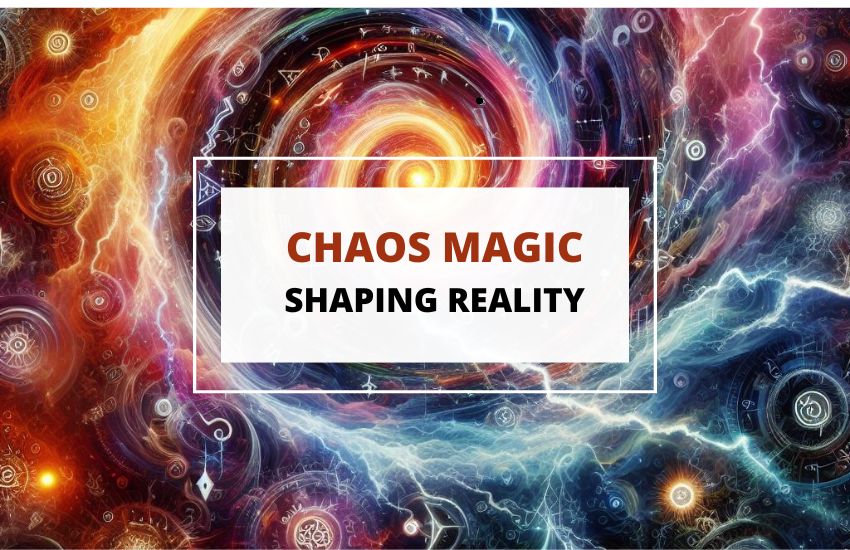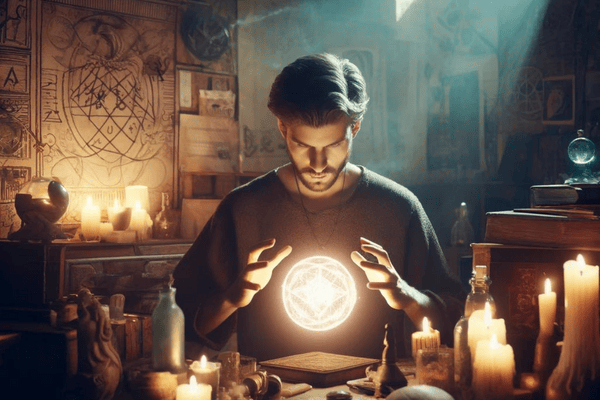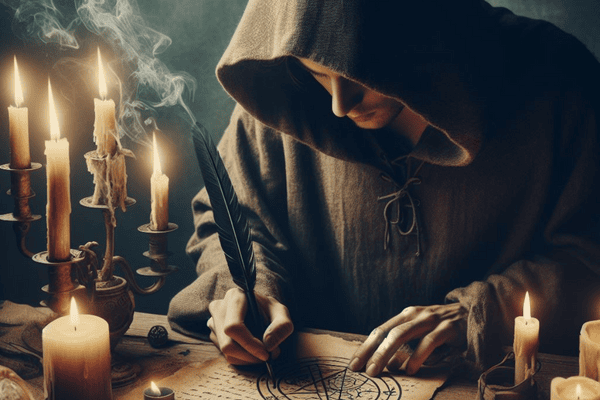
Table of Contents
Chaos magic stands out in the mystical world, mixing practicality with magic. It focuses on personal trials and cleverly using beliefs, allowing users to mould reality with a mix of various methods. This powerful approach motivates people to explore and master the art of what’s possible.
Let’s take a closer look at the secrets of Chaos magic, how it works, and its impact on the modern spiritual world.
What is Chaos Magic?

Chaos magic is a modern form of magic that values practical results over following strict rules. Unlike older magical traditions that depend on set rituals and symbols, chaos magic is much more flexible. It believes that the true source of magical power is the practitioner’s own belief, not outside forces, or tools. This approach encourages individuals to use whatever methods or ideas work best for them, mixing different magical and philosophical traditions.
The key idea in chaos magic is using belief as a tool. Practitioners might temporarily adopt a belief to make their magic work stronger and then let it go once they achieve their goal. This makes chaos magic very adaptable, not tied down by traditional ways.
Chaos magic also has a unique take on ethics, leaving it up to each person to decide what’s right or wrong. This openness has made chaos magic attractive to those looking for a more personal and direct experience with the mystical, despite some debates about its place in the wider magical community.
Origin and History of Chaos Magic

Chaos magic emerged through the efforts of Peter J. Carroll and Ray Sherwin in England during the late 1970s and early 1980s. They established the core ideas of chaos magic in important books like Carroll’s “Liber Null” and Sherwin’s “The Book of Results.”
This period was marked by questioning of old beliefs and structures, along with a renewed interest in occult practices. However, many people were seeking something different from the traditional and hierarchical magic systems like Thelema and the practices from the Hermetic Order of the Golden Dawn.
In response, chaos magic focused on results and personal exploration over following specific traditions or systems. It introduced the idea of using belief as a flexible tool, where beliefs can be changed as needed to make magic work. This approach encouraged mixing various methods, including those from psychology, science fiction, and classic magic traditions.
A key concept in chaos magic is the importance of the practitioner’s intentions and experiences over formal rituals or historical accuracy. This has led to innovation and a personalized approach to magic.
Over time, chaos magic has attracted a global following, partly thanks to the internet and online forums. It has evolved by integrating ideas from different areas, like quantum physics and postmodern philosophy, keeping it relevant today. Despite being relatively new, chaos magic has greatly influenced how magic is viewed and practiced, challenging the old rules about who can be a magician and how magic should work.
Chaos Magic Rituals and Techniques

Chaos magic supports tailoring practices to meet individual needs and preferences. Here are some primary techniques and rituals in chaos magic:
1. Sigilization
A key method in chaos magic, sigilization involves creating a symbol (sigil) that captures a specific wish or goal. The process includes writing out the goal, turning it into a unique symbol, and then energizing it through methods like meditation, visualization, or other forms of energy work. Often, the sigil is then either destroyed or hidden to let the subconscious mind pursue the goal without conscious interference.
2. Gnosis
Central to chaos magic is reaching gnosis, or a shifted state of consciousness, which is thought to boost the magician’s ability to affect reality. Achieving gnosis can involve a range of activities from meditation and chanting to more intense techniques like sensory deprivation or ecstatic dancing, among others.
3. Psychological Manipulation
This involves using psychological strategies to influence one’s own mindset or how others perceive things. Techniques can include affirmations, NLP (Neuro-Linguistic Programming), or self-hypnosis to strengthen the magician’s intent or goals.
4. Servitors
Servitors are thought-forms or entities crafted by the magician to carry out specific tasks. Creating a servitor involves defining its purpose, creating a symbol or form for it, and energizing it with focused intent. Once the task is complete, the servitor is typically deactivated or allowed to fade away.
5. Chaosphere Work
Unique to chaos magic, the chaosphere represents the magician’s personal world of belief and magical practice. Working with the chaosphere means intentionally shaping and nurturing one’s magical and mental space to support their magical efforts and personal growth.
6. Ritual and Ceremonial Work
While known for moving away from traditional rituals, chaos magic practitioners may still perform rituals that are highly personalized, crafted to align with their specific wishes and beliefs rather than fixed formats.
7. Technomancy
In line with its contemporary origins, chaos magic integrates technology into its practices, such as using electronic gadgets in rituals, crafting digital sigils, or employing software and the internet as magical tools.
Chaos Magic in Popular Culture

Chaos magic has found its way into popular culture, influencing various forms of media such as books, comics, movies, and TV shows. Its mysterious and rebellious qualities, along with its focus on personal empowerment and change, match well with today’s themes of finding oneself and asserting individuality.
In books, particularly fantasy novels, we see chaos magic as a way characters can change reality through their beliefs and intentions, mirroring the actual concepts of chaos magic. Comics have particularly embraced this idea, with characters like Marvel’s Scarlet Witch using powers that are often linked to chaos magic, offering rich stories about personal power’s boundaries.
Movies and TV shows have also explored chaos magic, showing characters and stories centered on changing reality with willpower or belief, adding a unique twist to traditional magic tales. These stories sometimes mix chaos magic with other magical ideas, showing its flexible nature.
The internet has also played a crucial role in spreading chaos magic, with online forums, podcasts, and videos discussing it, making it more known in popular culture. This digital sharing has introduced chaos magic to a broader audience and inspired new followers, keeping the intrigue around chaos magic alive and presenting it as a contemporary version of ancient magical practices.
Everyday Uses of Chaos Magic
The use of Chaos magic in daily life is highly flexible and focused on getting results, allowing people to customize their magical practices to achieve personal goals and tackle everyday challenges.
For personal growth, techniques like creating sigils and entering different states of consciousness can help individuals improve aspects of themselves, such as confidence, motivation, or focus. It’s also useful in work settings, where adjusting one’s beliefs and intentions can boost creativity, overcome obstacles, or open up new job opportunities.
In relationships, chaos magic methods can enhance communication, increase understanding, and help solve disputes. For stress management and mental health, practices like meditation and visualization can lead to a more relaxed and focused mind.
Chaos magic emphasizes the importance of belief and the power each person has to change their reality, making it a flexible approach for dealing with the complexities of life and achieving desired results.
Ethics and Controversy Surrounding Chaos Magic
Chaos Magic’s deep impact on reality brings with it ethical challenges and common misunderstandings. Like any influential tool, it requires users to act responsibly. Critics often view its adaptability as a sign of lacking seriousness or ethical foundation. Yet, this very adaptability allows practitioners to follow a path marked by personal integrity and ethical awareness.
The core of Chaos Magic—using belief to shape reality—sparks ethical debates. It raises questions about the outcomes of such practices, whether they’re intended or not, urging a thoughtful consideration of ethics. Misconceptions about Chaos Magic usually come from not understanding its principles, leading to views of it being risky or unfounded.
This practice also motivates people to test the limits of their beliefs and reality, offering freedom but demanding caution. Such exploration requires an acute awareness of one’s actions and their broader effects.
Practitioners must weigh the impact of their magical actions beyond their own lives, considering their effect on the community and environment. This calls for a practice that is ethically mindful as much as it is spiritually enriching.
Modern Chaos Magic
Modern chaos magic is constantly changing, adapting to new technologies and societal shifts while keeping its fundamental focus on flexibility, practicality, and the importance of the magician’s intention.
Nowadays, chaos magicians often incorporate digital tools into their practices, such as using software to design sigils or sharing their experiences and techniques on social media and blogs. The internet plays a crucial role in connecting practitioners worldwide, allowing them to share ideas, work together on projects, and enhance their practices with diverse influences.
Modern chaos magic also reflects postmodern ideas, especially in how it views truth and reality as flexible and shaped by personal belief. This approach supports the chaos magic principle of freely changing beliefs to suit one’s needs, underlining the individual’s power over their reality.
Inclusivity is a key feature of today’s chaos magic, welcoming people from various backgrounds and valuing a broad spectrum of spiritual, philosophical, and scientific views. It moves away from old-fashioned magical hierarchies and rules, offering a more open and democratic approach to magic that empowers anyone willing to learn and experiment.
Although focusing on personal practice, the sense of community is still strong. Practitioners gather online and in person to share knowledge and support each other’s development. This balance of independence and community support makes chaos magic a lively and relevant field in today’s occult world.
The Future of Chaos Magic
The future of chaos magic is set to grow and evolve, mirroring larger trends of valuing individuality and merging science with spiritual practices. With our world becoming more connected through digital means, chaos magic’s ability to adapt might lead it to incorporate more digital and virtual elements, like augmented reality or rituals powered by artificial intelligence.
The increasing interest in personal growth and empowerment fits well with what chaos magic offers, potentially drawing more people to explore this unconventional spiritual path. As conversations around mental health and wellness gain prominence, chaos magic’s practical and individualized approach could be integrated into broader health and wellness practices.
In the end, chaos magic is likely to keep innovating, with its practitioners pushing the boundaries and trying out new approaches, helping it stay relevant in a rapidly changing society.
Wrapping Up
Chaos magic combines traditional elements with new ideas, appealing to those looking for a custom spiritual journey. Its flexibility and emphasis on belief provide a distinct way to practice magic today, suggesting a continuously growing practice that pushes and inspires the limits of the mystical world.








